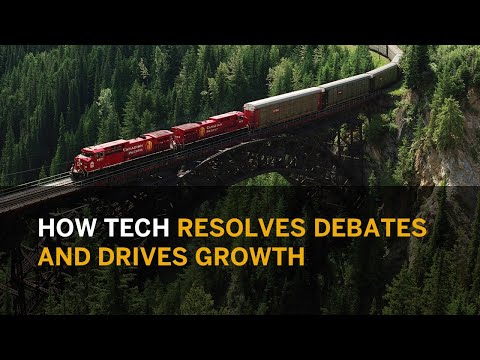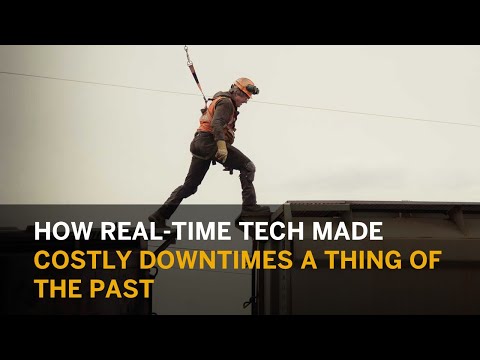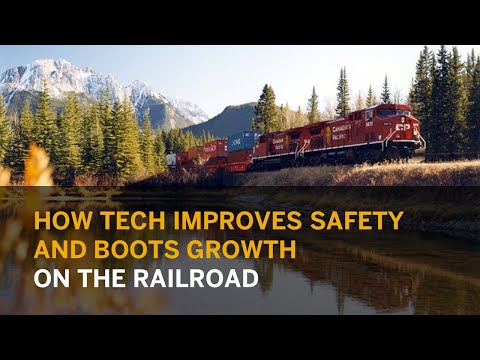Railways of the 21st century transport just about everything we buy in stores, via ecommerce and elsewhere. The most tech-savvy among them are also keeping people employed and enabling cross-border trade during the COVID-19 crisis.
“The flow of groceries, pharmaceuticals, and other essential goods is a stark reminder that transportation networks that bring those necessities to people are as vital as the goods themselves,” Global Railway Review noted last month. “The industry has long been preparing for a future — in which freight demand will rise by nearly 40 percent over the next 20 years — investing in technology, streamlining operations, and modernizing services.”
Canadian Pacific (CP) is ready for this future, having undergone a digital transformation that helps CP run its network spanning more than 13,000 miles of railroad across the U.S. and Canada — along with people, freight, and equipment.
A single source of truth across multiple systems offers CP greater control of its data and business processes.
“Railway is playing a mission-critical role in helping products move across North America,” CP Chief Information Officer Mike Redeker said. “We help the economy, not only moving the products, but we help people maintain their jobs, whether they’re at the ports, the trucking companies, [or] a Walmart or Target.”

In-memory technology helps CP do all of this faster and more efficiently than ever before.
When Trains Aren’t Your Only Fast and Stable Assets
“It’s very fast, I mean blindingly fast, where we had some processes that used to take five, six hours now take minutes,” said Dean Stoffel, director of Program Management for SAP Technical Services at CP. “The stability that gave us, and the credibility with our end customers inside of CP, helped shift perspectives of us to more of a partner than a cost. It’s been a huge impact.”
That’s because when a CP system is down, that outage delays the company’s trains, and longer delays cost the business more and more time and money. SAP HANA has helped dramatically reduce CP system downtime.
“Over the course of six years, we’ve moved from about 1,200 hours down to between 15 and 60 hours on an annualized basis,” Redeker said. “You can see the productivity improvement in the movement of trains and cost savings.”
System outages at CP have gone from weekly ordeals to a blip every few weeks or months, according to Redeker and Stoffel. Outages longer than 30 minutes cause problems — while outages below that half-hour threshold have virtually no impact on the business.
“Before, we could have a system down for six, eight hours. Now a 10-minute or 20-minute interval is my max downtime for a hard crash,” Stoffel said. “That means that even if we do have a high-severity issue on one of our systems, the outage is very short.”

That also means that IT has become an engine for growth.
Partner Ecosystem Moves CP Beyond IT
CP has moved beyond traditional IT roles, according to Redeker and Stoffel. They describe their team as a flexible support structure that enables growth and success throughout the company, from operations to sales to marketing and more.
“Uptime is king, but that stability has given us the ability to deliver more to our business,” Stoffel shared. “As we made this journey on a more standardized SAP HANA-based environment, we’ve increased by seven-fold our delivery of new processes and technologies to the business; yet our stability has not decreased.”
Delivering more to the business has been especially important during the COVID-19 pandemic, as more employees than ever work from home, according to Stoffel. And a rich partner ecosystem has also improved CP’s ROI:
- SAP MaxAttention helped CP migrate to SAP HANA, optimizing the platform
- Intel Optane Persistent Memory, based on the Xeon processor, helps ensure much faster restart times when outages occur
- Cisco teamed with Intel for new memory and new processor technology
Together with SAP HANA, these technologies help CP better manage memory and minimize downtime.
“Whether it’s Intel, Cisco, or SAP, every one of these business partners are critical to our success. If any one of us fails, we all fail,” Redeker said. “We could not be where we are today — as an organization in a maturing IT shop — without the partnership from these vendors.”

That’s especially powerful in an organization with data going back to 1881.
More Powerful Than A Locomotive
“We’re a 130-plus-year-old company, we’ve got a lot of data out there,” Stoffel said. “But when we migrated this, we had a 10-minute actual system outage — 10 minutes — to migrate more than six terabytes!”
That “unheard of” number is indicative of the substantial efficiency and stability of SAP HANA, according to Stoffel. Those qualities, in turn, save CP significant money on data storage, given the capabilities of the ecosystem’s software and hardware, and how well integrated they are.
“We have more [data] in one place, which means we don’t have to duplicate it as much,” Stoffel said. “We have more accurate information for our business users, and smaller systems take less time to come up. And fewer systems mean less total cost of ownership.”
Keeping Us Connected
All of this helps CP continue to connect North America and the world, even as COVID-19 keeps road borders between the U.S. and Canada closed. This 21st-century railway continues to move goods between the two countries.
“The rail industry is considered an essential service in North America, and we’re able to cross the border into the U.S. and back on a regular basis,” Redeker said. “We’re able to do that freely, and we do it daily.”
Listen to more episodes of In Focus
Follow Derek on Twitter: @DKlobucher



